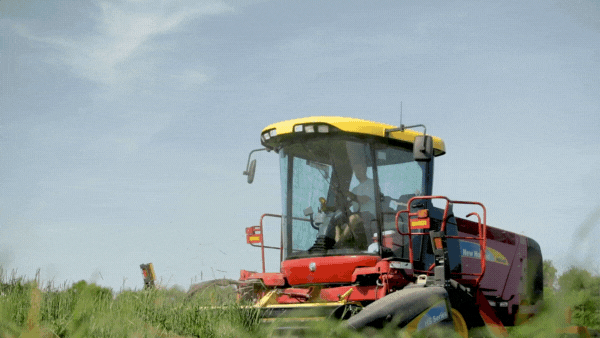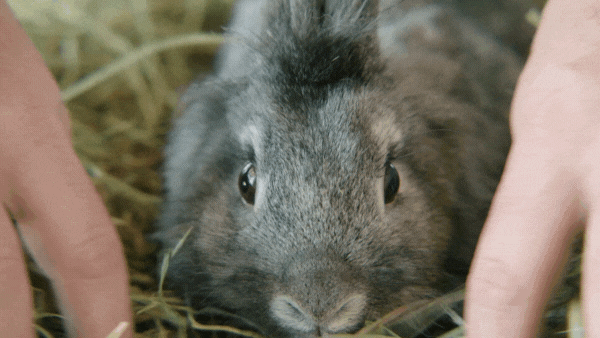One of the questions we receive from astute pet parents is whether it’s normal for hay to vary in color, texture, and even smell from bag to bag. It’s a great question, and the short answer is “yes.” However, there are many factors to consider when it comes to hay variability. Knowing us to be the “hay nerds” that we are, we’re going to dive a little deeper into the following subjects in this article:
- How is hay grown and harvested and how does that affect hay variability?
- What are the natural factors that affect hay variability?
- What type of hay variability is normal and what’s not?
- Color
- Aroma
- Texture
- What does Oxbow do to limit variability from one bag of hay to the next?
How Is Hay Grown and Harvested and How Does That Affect Hay Variability?
Have you ever considered where your pet’s hay comes from? Unless you were raised on a farm, you may not be familiar with how hay is grown and harvested and the various nature-related factors that determine the way the bag or box of hay you buy for your pets looks, feels, smells, and tastes.
Hay is grown and harvested on farms throughout the world to feed herbivorous animals of all shapes and sizes. From the largest cows and horses to the smallest chinchilla or guinea pig, herbivores rely on the fiber in hay to meet their specific digestive needs.
Hay is a single ingredient product and is minimally handled between the field where it is grown and the time you feed it to your pet. When hay reaches maturity, it is harvested using a series of basic mechanical processes. These include:
- Mowing
- Tedding (Optional)
- Windrowing
- Baling
Mowing
Hay is mowed (i.e. cut) when it is determined that the nutrients are at optimum levels to support the health of the animal it is intended for. For Oxbow, this means working hand in hand with our family of farmers to ensure the hay meets the specific nutritional requirements, as well as taste and texture preferences, of rabbits, guinea pigs, and chinchillas. To accomplish this, Oxbow hay is cut at an early stage in the growth cycle.
Tedding (Optional)
Depending on drying conditions, hay may undergo a process called tedding after it has been cut. A hay tedder utilizes metal forks to aerate or “fluff up” the cut hay. This promotes efficient curing and drying, which typically leads to improved color and aroma.
Windrowing
Once hay has been tedded and the topside is nearly dry, it is flipped with a machine called a windrower. This process allows the underside of the hay to dry. Windrowing typically occurs just before baling.
Baling
The final step in the hay harvest process is baling. The baling process mechanically compacts loose hay into large bales that are held together with colored twine. Baling is the final and most important step that prepares the hay for storage.
What Are the Natural Factors That Affect Hay Variability?
As a natural product, no two bags of hay will ever be exactly alike. This is because there are ever-variable, nature-related factors that ultimately determine the look, feel, smell, and taste of the hay you purchase for your little loved one. These factors include:
- Geography
- Temperature
- Air Movement
- Humidity
- Precipitation
Geography
Having a geography with the right climate is key to the production of premium hay. The ideal climate ensures greater consistency with factors such as temperature, humidity, and precipitation. A majority of Oxbow’s hay is grown in the western United States where conditions are ideal for producing premium quality hay on a consistent basis.
Temperature
Grass hays like Timothy and Orchard are classified as “cool season” grasses. This means these varieties grow better in climates (like the western U.S.) that have lower temperatures on average. Cool nights aid in the growth of these cool season grasses and warm, dry summer days help to dry the hay out quickly to be baled.
Air Movement
Air movement in the form of breezes or winds helps with the natural drying process of hay.
Humidity
In general, lower humidity is what is ideal for producing premium hay. Some humidity is necessary, however, especially when the hay is ready to be baled. The right amount of dew on the hay at the time of baling helps ensure it is soft and appealing to small pets like rabbits, guinea pigs, and chinchillas.
Precipitation
Adequate precipitation is essential to the development of hay throughout the growing season, making precipitation hay’s friend at this time. As soon as hay is cut and waiting to be dried and baled, however, precipitation becomes hay’s greatest enemy. For this reason, much of Oxbow’s hay is grown in arid climates that don’t historically receive a lot of rainfall. In these areas, the hay is grown under irrigation for controlled watering at the right time.
What Type of Hay Variability Is Normal? What Should I Be Concerned About?
As we’ve learned, some variability is perfectly natural when it comes to hay. Next, let’s take a look at what type of variability should be expected and what should be cause for concern when it comes to attributes such as color, texture, and aroma:
Color
Hay that is a rich green in color is the first choice of most pet parents, and it’s easy to understand why. Hay that is a nice green color is not only more visually appealing on the shelf. More importantly, green, healthy-looking hay is likely to have been cut and baled under the right conditions we typically strive for with premium hay. However, it’s important to understand that some variation with color is perfectly normal and is the result of the variables we discussed above in relation to how and where hay is grown.
What’s Normal:
- You’re likely to encounter a spectrum of different shades of green when you’re regularly buying hay for your rabbit or guinea pig.
- Even small variations with any of the factors above (temperature, air movement, humidity, and precipitation) can result in some degree of variation when it comes to color.
- A small amount of “brown leaf” hay is natural. The lower portions of the hay plant turn brown naturally as hay matures during the growing season.
What to Avoid:
- Avoid hay that is completely brown or sun-bleached. These can be indicators of hay that has been on the shelf or in inventory for too long and you may have a hard time convincing your pet to happily munch on this type of forage.
Learn more about the many factors that can affect the color of hay.
Texture
Generally speaking, texture is an indicator of maturity. The more mature hay is, the coarser the texture will be. To achieve hay that is consistently soft and pliable in the bag, Oxbow strives to cut our hay at an early maturity.
What’s Normal:
- Similar to color variability, you may encounter slight variation in texture from hay bag to hay bag.
- Some varieties (like Orchard Grass, for instance) are softer by nature. Others (like Oat) are naturally more stemmy and coarse.
- Similarly, a certain amount of “dust” is normal to find at the bottom of the hay bag. Rather than dust, these fine particles are mostly made up of finely ground leaves that sift to the bottom over time.
What to Avoid:
- Hay that feels overly crunchy or brittle in the bag.
Aroma
Like color and texture, aroma is another key quality indicator when it comes to hay. Fresh, high-quality hay has a distinct pleasant aroma. An unpleasant or non-existent aroma can be an indication of hay that should be avoided.
What’s Normal:
- Hay with a fresh, natural aroma
What to Avoid:
- Hay with a musty aroma or any aroma that smells “off” to you. This could be an indicator of mold and could pose harm to your pets.
- Hay with a dull or non-existent aroma. This can be an indication of hay that’s been stored for too long.
What Does Oxbow Do to Limit Variability From One Bag of Hay to the Next?
Now that you’ve learned about how hay is grown and harvested and the many factors that can affect variability, you’re probably asking yourself what Oxbow does to limit variability and ensure every bag of Oxbow hay lives up to our 30+ year reputation.
To put it simply, producing “Hay the Oxbow Way” is no small feat. Our decades-long relationships with our family of farmers allows us to work hand in hand to grow hay that meets the specific nutritional needs and taste and texture preferences of even the pickiest of pets.
In the Field
In the field, our hay experts go the “extra acre” to evaluate key quality attributes essential to the production of premium hay. These attributes include color, texture, maturity, and stem-to-leaf ratio.
Sampling, Testing & Analysis
At Oxbow, our product quality team samples, grades, and nutritionally tests our hay to make sure it’s up to the challenge of nourishing your pet. This includes 3rd party nutritional and food safety testing, and organoleptic analysis which assesses odor, flavor, appearance, and texture.
Sorting & Packaging
Oxbow hay is gently combed to loosen it from the bale. Next, we carefully sort out smaller pieces, removing any natural foreign materials. Finally, we extract as much natural dust from the hay as possible & expertly sort the hay by hand for that extra personal touch.
Customer Support
Our commitment to you and your little loved ones doesn’t end with a purchase. Oxbow is made up of fellow animal lovers who want to provide support throughout the entire long, happy life of your pets. This means caring customer support is always just a phone call or email away.
Learn more about Hay the Oxbow Way
Want to Learn More About Hay Quality? Check Out These Great Resources:
Get to Know Oxbow’s Forage Research & Sourcing Manager
Fun Ways to Feed a Variety of Hays
How Much Hay Should My Pet Eat Each Day?


